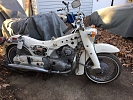honda ca72 ca77 dream vintage
1964 Honda CA
| Price: | US $550.00 |
| Item location: | Santa Rosa, California, United States |
| Make: | Honda |
| Model: | CA |
| SubModel: | 77E |
| Year: | 1964 |
| Mileage: | 999 |
| VIN: | CA77E-315683 |
| Color: | Black |
| Engine size: | 305 |
| Vehicle Title: | Rebuilt, Rebuildable & Reconstructed |
| Contact seller: | Contact form |
Claimed power: 23hp @ 7. 00rpm Engine: 305cc air-cooled OHC parallel twin. 60mm x 54mm bore and stroke Top Speed: 86mph Weight (dry): 350lb (159kg) Fuel capacity/MPG: 2. 5gal (9. 5ltr)/50-70mpg Price then/now: $595/$1. 00-$4. 00 The final development of these bikes. the C72/C77. was available from 1960. A 1960 C72/C77 would be a very rare bike; most came out in 1961. The American market CA72/CA77 was available in 1961. These bikes were made until 1967. although it seems that because of the way US bikes are dated. many are referred to in the US as 1968 or even 1969 models. These bikes saw a completely redesigned engine: a wet-sump design with many internal differences. essentially a new motor. with electric start and 12v system. The C72 and C77 had pressed steel handlebars. while the CA72 and CA77 had high tubular bars. Beyond that there were only minor differences. different indicators were fitted to the non-US bikes to suit the countries laws. Bikes built up to 1963 had a different fuel tank shape to later bikes. and the pressed steel bars were discontinued at about the same time (all models using conventional tubular bars) but otherwise the bike stayed much the same for the rest of its run. There was also a version of the bike called the C78/CA78. but visually there were no substantial differences to the C77/CA77. Pre-1963 CA77s were considered as well-equipped touring/commuter bikes � not particularly sporting. but reliable and comfortable. with a turn of speed much better than many larger-capacity bikes. Like the earlier dry-sump bikes. there were high-exhaust sports version. the CS72 and CS77. and the corresponding American market CSA72 and CSA77. The C72/C77 was exported to Europe. Britain. Australia and other markets. and sold in some numbers. although as it was comparatively expensive. not as well as hoped. Post-WW2 anti-Japanese sentiment was still rife. and in the UK. manufacturers like BSA and Triumph attempted to convince dealers not to sell Japanese bikes. Also. the style was considered to be somewhat unusual to European eyes. and by the mid-1960s quite old-fashioned in appearance.
Also published at eBay.com


